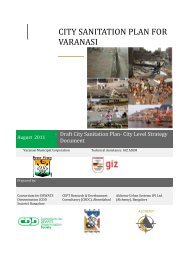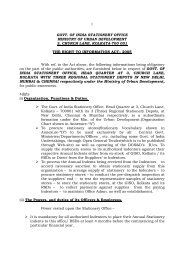CITY SANITATION PLAN - Ministry of Urban Development
CITY SANITATION PLAN - Ministry of Urban Development
CITY SANITATION PLAN - Ministry of Urban Development
Create successful ePaper yourself
Turn your PDF publications into a flip-book with our unique Google optimized e-Paper software.
<strong>CITY</strong> <strong>SANITATION</strong> <strong>PLAN</strong> BAREILLY<br />
the sewer and forcing a length <strong>of</strong> rigid wire through the sewer. Inspection chambers must be<br />
emptied periodically to prevent grit overflowing into the system.<br />
Pros & Cons:<br />
Can be built and repaired with locally available materials<br />
Construction can provide short-term employment to local labourers<br />
Capital costs are between 50 and 80% less than Conventional Gravity Sewers; operating<br />
costs are low<br />
Can be extended as a community changes and grows<br />
Requires expert design and construction supervision<br />
Requires repairs and removals <strong>of</strong> blockages more frequently than a Conventional Gravity<br />
Sewer<br />
Effluent and sludge (from interceptors) requires secondary treatment and/or appropriate<br />
discharge.<br />
Reference: Mara, DD, (1996) Low-Cost Sewerage, Wiley, Chichester, UK. (Assessment <strong>of</strong> different<br />
low-cost systems and case studies)<br />
Anaerobic Baffled Reactor (Popularly called as DEWATS)<br />
Application Level- Neighborhood, Household, Public<br />
An Anaerobic Baffled Reactor (ABR) is an improved septic tank because <strong>of</strong> the series <strong>of</strong> baffles under<br />
which the wastewater is forced to flow. The increased contact time with the active biomass (sludge)<br />
results in improved treatment. The system operates without mechanical means and sewage flows by<br />
gravity through the different components <strong>of</strong> the system. Up to 1,000 cubic metre <strong>of</strong> domestic and<br />
non-toxic industrial sewage can be treated by this system. DEWATS applications are based on the<br />
principle <strong>of</strong> low-maintenance since most important parts <strong>of</strong> the system work without electrical<br />
energy inputs and cannot be switched <strong>of</strong>f intentionally (BORDA). DEWATS applications provide<br />
state-<strong>of</strong>-the-art-technology at affordable prices because all <strong>of</strong> the materials used for construction<br />
are locally available. DEWATS approach is an effective, efficient and affordable wastewater<br />
treatment solution for not only small and medium sized enterprises (SME) but also for the un-served<br />
urban households in developing countries, especially South Asia. For instance, DEWATS can operate<br />
in individual households, at the neighborhood level and even in small and big factories not<br />
connected to sewage lines. DEWATS can also treat municipal waste. The recycled water is used for<br />
ADMINISTRATIVE STAFF COLLEGE OF INDIA, HYDERABAD Page 159
















